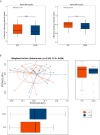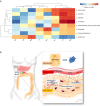Alterations of the Human Gut Microbiota in Intrahepatic Cholestasis of Pregnancy
- PMID: 33996622
- PMCID: PMC8120235
- DOI: 10.3389/fcimb.2021.635680
Alterations of the Human Gut Microbiota in Intrahepatic Cholestasis of Pregnancy
Abstract
Background and aims: Women with severe intrahepatic cholestasis of pregnancy (ICP) are at higher risks of fetal complications and without effective treatments. Changes in gut microbiota in pregnancy were found to be related to the altered intestinal bile acid composition, so we aimed to explore the alterations of microbiota in the gut of ICP patients.
Methods: A total of 90 women were recruited, including 45 ICP patients and 45 healthy controls. The gut microbiota communities of ICP group were compared to control group through 16S ribosomal RNA gene sequencing. The results were then confirmed by real-time polymerase chain reaction (PCR) and generalized linear model (GLM). Furthermore, we analyzed the relationships between microbiota and the severity of ICP.
Results: A total of seven genera and nine taxa with differential abundances between the ICP patients and the controls were identified. All of the seven genera were verified through real-time PCR, and three key genera Parabacteroides, Flavonifractor, and Megamonas were confirmed by using the GLM model. Further analysis found that the genera Escherichia_Shigella, Olsenella, and Turicibacter were enriched in the severe ICP group, the microbial gene function related to biosynthesis of unsaturated fatty acids and propanoate metabolism were also increased in them.
Conclusions: Overall, our study was the first in Asia to demonstrate an association between gut microbiota and ICP. Our findings would contribute to a better understanding of the occurrence of ICP.
Keywords: Escherichia_Shigella; Olsenella; Turicibacter; biosynthesis of unsaturated fatty acids metabolism; propanoate metabolism pathway; severe ICP.
Copyright © 2021 Zhan, Qi, Weng, Xi, Chen, Wang, Hu, Zhao and Luo.
Conflict of interest statement
The authors declare that the research was conducted in the absence of any commercial or financial relationships that could be construed as a potential conflict of interest.
Figures




Similar articles
-
Response of gut microbiota to serum metabolome changes in intrahepatic cholestasis of pregnant patients.World J Gastroenterol. 2020 Dec 14;26(46):7338-7351. doi: 10.3748/wjg.v26.i46.7338. World J Gastroenterol. 2020. PMID: 33362388 Free PMC article.
-
Characterization of gut microbiota associated with clinical parameters in intrahepatic cholestasis of pregnancy.BMC Gastroenterol. 2020 Nov 23;20(1):395. doi: 10.1186/s12876-020-01510-w. BMC Gastroenterol. 2020. PMID: 33225888 Free PMC article.
-
Profiles and integration of the gut microbiome and fecal metabolites in severe intrahepatic cholestasis of pregnancy.BMC Microbiol. 2023 Oct 3;23(1):282. doi: 10.1186/s12866-023-02983-x. BMC Microbiol. 2023. PMID: 37784030 Free PMC article.
-
Research progress in the role of gut microbiota and its metabolites in intrahepatic cholestasis of pregnancy.Expert Rev Gastroenterol Hepatol. 2021 Dec;15(12):1361-1366. doi: 10.1080/17474124.2021.2011211. Epub 2021 Dec 3. Expert Rev Gastroenterol Hepatol. 2021. PMID: 34845962 Review.
-
Intrahepatic cholestasis of pregnancy: changes in maternal-fetal bile acid balance and improvement by ursodeoxycholic acid.Ann Hepatol. 2002 Jan-Mar;1(1):20-8. Ann Hepatol. 2002. PMID: 15114292 Review.
Cited by
-
The interplay between the gut microbiota and metabolism during the third trimester of pregnancy.Front Microbiol. 2022 Dec 7;13:1059227. doi: 10.3389/fmicb.2022.1059227. eCollection 2022. Front Microbiol. 2022. PMID: 36569048 Free PMC article.
-
Antibiotic treatments to mothers during the perinatal period leaving hidden trouble on infants.Eur J Pediatr. 2022 Sep;181(9):3459-3471. doi: 10.1007/s00431-022-04516-6. Epub 2022 Jun 10. Eur J Pediatr. 2022. PMID: 35680662 Free PMC article.
-
Pruritus in Pregnancy.Am J Clin Dermatol. 2022 Mar;23(2):231-246. doi: 10.1007/s40257-021-00668-7. Epub 2022 Feb 21. Am J Clin Dermatol. 2022. PMID: 35191007 Free PMC article. Review.
-
Causal association between gut microbiota and hyperemesis gravidarum: a two-sample Mendelian randomization study.Front Microbiol. 2024 Apr 3;15:1307729. doi: 10.3389/fmicb.2024.1307729. eCollection 2024. Front Microbiol. 2024. PMID: 38633695 Free PMC article.
-
The causal role of intestinal microbiome in development of pre-eclampsia.Funct Integr Genomics. 2023 Apr 17;23(2):127. doi: 10.1007/s10142-023-01054-8. Funct Integr Genomics. 2023. PMID: 37069411 Free PMC article.
References
Publication types
MeSH terms
Supplementary concepts
LinkOut - more resources
Full Text Sources
Other Literature Sources
Medical

